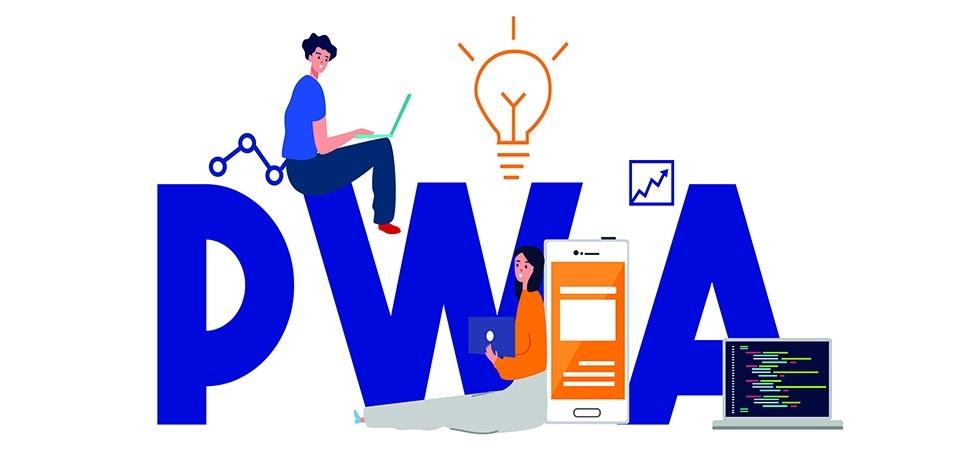Innovations in eCommerce you can’t miss in 2021

It’s around a year since we have engaged in the COVID-19 lockdown. During these twelve months, the majority of us haven’t expected that we would still have to adapt to this new reality. Few of us could predict how much would change in terms of worldwide trade and eCommerce during this time. The size and pace of this growth caused many businesses, which were late to implement innovations and digitalize, to fight with many problems, not seldomly with bankruptcy itself. The 2020 has passed and with it many companies, which had not applied the latest technologies at all or too late. In this article, we’re writing about innovations that cannot be missed in 2021.
PWA – the game changer
Progressive Web Applications are known as one of the most effective innovations in eCommerce. The businesses which implemented this technology have registered significant increases in conversion rates and the number of active users and sessions. Additionally, the reports show a decrease in the bounce rates and an increase in the average time spent on-site. How is this possible?
Mobile conversion
Over half of the worldwide Internet users connect via mobile devices. This has been the case since the rapid growth of mobile technology in the beginning of the past decade. However, for a long time this growth has not increased the overall conversion rate. The number of unique purchases made on mobile devices was disproportionate to the number of active mobile sessions.) The main reason for this was the low optimization of mobile devices software infrastructure. As a result, it has led to longer website loading times and lower quality of the mobile pages themselves. Some tried to alleviate this with coming up of native applications. However these apps required downloading, installing and updating by the users.
Why is it worth getting PWA?
PWA offers a way out of the desktop-mobile dilemma by having all the advantages of both platforms. That’s because the PWA has mechanics and characteristics present in the web apps and the native ones. Moreover, the innovation has a special “connector” between the front-end and the back-end of the application. It works as a cache storage that enables the app to run offline. And that is just one of the many advantages Progressive Web Applications have.
Easier and faster access to your store
With PWA, the user is not forced to download apps from the Google Store or Apple Store. These operations usually come with the necessity of creating an account, e-mail verification and a few other steps that can discourage potential buyers. However, the PWA allows the omittance of the requirements and additionally saves the customers’ mobile data. In the end, the direct path to the purchase summarisation is significantly shorter.
Quick loading times
The web page loading time is one of the most crucial factors in increasing the conversion rate. According to the studies, if the loading time prolongs from 1 to 3 seconds, the bounce rate increases by 32%. When it goes up to 5 seconds, the rate increases furthermore by 90%. Therefore, it goes without saying that PWA plays the crucial role in increasing the conversion rate in mCommerce. After all, the implementation of Progressive Web Applications has resulted in almost four times faster speed of the loading times.
Voice-search compatibility
The sales of smart-speakers are on the rise, so is the percentage of the online voice searches. The most popular of them are devices made by Amazon and Google, because they are exquisitely good for voice order collection, which the customers later realize in browser or on mobile devices. This seamlessly accelerates the shopping process. That is why the PWA supports voice-searching.
Access to the native apps functions
Despite many restrictions of mobile devices, they have tools that can actually become advantageous in eCommerce. Utilisation of GPS, camera, barcode scanning is not available on desktop websites. However, with the adjustment of mobile websites with the PWA, we are suddenly equipped with those solutions without paying the “quality tax” usually related to mobile apps. As a result, this increases the personalisation possibilities of shopping experience.
PWA in statistics
Good results don’t need good marketing. The same goes for Progressive Web Applications; the number of businesses, which decided to implement this solution speaks for itself. Each of those companies has noted measurable improvements coming from the exertion of PWA. Some of them managed to slim down their apps size (Twitter went down from 23,5MB to 600KB), some have shortened their loading times (Lancome: 9 seconds to 3.5 after PWA implementation) as well as prolonged the average length of time spent on-site (George.com increase by 28%).
PWA is one of many innovations getting popularity in eCommerce, but it is the one that dictates the future of e-business and brings the real modern customer closer.
Omnichannel and other hybrid innovations
The more brand is present in the everyday life of the customer, the more used to it they get. The omnichannel approach, which translates to the use of every possible channel of contact with the customers improves communication and research on their expectations and behaviours. Furthermore, it helps in more direct advertising and marketing, often realised at lower costs, thanks to the use of social media.
But pros of utilising omnichannel don’t stop at B2C communication. When used properly, we adjust the multiway sales model, which increases the customer satisfaction and the number of shopping engagement opportunities. In spite of the undisputed growth of eCommerce in Poland and the record-breaking implementation of 11 thousand e-stores, there are still markets, which are harder to digitalise.
The biggest one is the market of FMCG – fast moving consumer goods, such as, food and cosmetics. It is one of the least digitised markets with the percentage of e-sales reaching around 1%. At the same time the worth of annual sales is larger than 250 billion zloty (more than 54 billion euros).
The introduction of omnichannel and hybrid sale models is going to enable the potential “sleeping” in this sector. What’s more, it can cover the COVID-related losses in offline sales, and even increase the overall profit with e-stores implementation. Needless to say, the FMCG market is a problematic branch of retail trade, especially when it comes to the food market. Lots of customers prefer the traditional stores, as they enable them to assess the quality of bought products. They don’t want to rely on shipping methods, because the deliveries rule out the possibility of QA on the go. Here, enter the phygital solutions.
Phygital stores
Phygital is a great tool for the customers who don’t want to use delivery options. Most of the time, they will prefer the Click and Collect method. Phygitalisation helps customers in making orders inside the store. This solution saves the need of queueing, which has always been a big problem for the sellers and during the last year it has become even more problematic. Simultaneously, the customers keep the ability to assess the chosen goods and don’t have to worry about reclamation and return processes. Actually, this solution has been successfully implemented by Argos, a British company, which combined the warehouse approach with the offline store. Additionally, they have placed electronic kiosks inside every physical store. As a result, the potential customers can browse the store offer while in the store.
Phygitalisation can also lower the costs in other sections of the retail. The business owners are not forced to rent large venues and don’t have to worry about the distribution and presentation of the goods. Thus, this sale model allows much more comfortable and spontaneous shopping. What’s more it also offers the customers greater flexibility both in choice of the products and the payment methods. Phygitalisation is a great step towards omnichannel implementation, however it requires a lot of time for realisation. That’s why it is best to begin it as soon as possible.
Beacons
Another part of the omnichannel strategy is the solution known as beacons. The beacons are devices sending a signal to the customer’s device in order to help them localize the wanted product. These devices are very affordable and enduring. They use BLE (Bluetooth Low Energy) technology for communication. They help in creation of the customer’s interest heat maps. In other words, they provide information on the product buying frequency and may be used as a data analysis tool, as well. Additionally, they improve user experience as they are another convenience for the customer, who does not have to look for the products by themselves.
Expert’s opinion on the innovations
The number of clients interested in PWA is growing. That’s because the businesses start to know what profits can PWA potentially bring to their businesses, thanks to the initial market surveys. – comments Adam Poznar, business analyst at Global4Net.
The page loading time is undoubtedly one of the most positively affected factors by PWA. It is an especially important aspect on the parts of websites that have the strongest influence on the conversion rate, such as the product list and the basket. The upcoming release of PWA Venia is going to both: quicken the process of PWA implementation and make it even more affordable.
The omnichannel approach-based solutions help in much more precise data gathering of the customers’ behaviours, using technologies like Google Analytics. Surely the aforementioned FMCG industry would profit better from an appropriate number of customers using various information sources about the brands. This trade branch, as much as any other, aims at shortening the path between the making of an order and its collection, because it solidifies the relationship between the customer and the brand. A Polish retail seller neonet.pl is an example of this strategy with its hugely popular “Pick up in an Hour” collection service.
Sales innovations in social media
The social media are a still growing sector, which can help the businesses to get their products and services to the biggest audience in the Internet. According to the Research & Market studies the overall worth of the social commerce market is going to increase by roughly 31% annually. The social media sales channels are not restricted only to dedicated groups and marketplaces. They also include personalised advertisements and offers reaching the customers on their social feeds and communicators.
Social media as new touch-points
The proper creation of sales and marketing channels in social media enables access to a totally new group of customers. In the last year, the number of social media users increased.
Over 3.8 billion people spend 6 hours and 43 minutes a day on average. No dedicated website comes even close to this. To compare, the actual leader of eCommerce market, Amazon, has had only around 2.5 billion average daily visits in 2020. Thus, ignoring the social media aspect in the e-business will bring losses. The introduction of services like Instagram Shops or Facebook Marketplace show how quickly the modern customer gets used to newer and more comfortable solutions.
Innovations became compulsory
The report conducted by PKO Bank and ITC predicts that around 20% of small and medium enterprises will disappear from the market in this year. At the same time, the increased role of eCommerce means, we cannot hold on to unchanged strategies and hope for the best. After all, we’ve reached times when the customer’s comfort is becoming more and more crucial not only to increase the profit rate but also to stay on the market. Therefore, we must think about innovations such as PWA, omnichannel and social commerce. The data shows clearly that these innovations are positively affecting the businesses prosperity.









